Indiana, known as the “Crossroads of America,” is a tapestry of contrasting landscapes. Its topography tells the tale of glacial times, unfolding across flat fertile farmlands in the northern and central parts and transforming into rugged hills and rocky features in the southern regions.
Meandering through the heart of Indiana, the Wabash River, the state’s official river, charts a captivating path from the northeast to the southwest. As it flows, it crafts a wide range of ecosystems, underlining the state’s biodiversity.
In this article, we discover the lowest point in Indiana.
What Is the Lowest Point in Indiana?
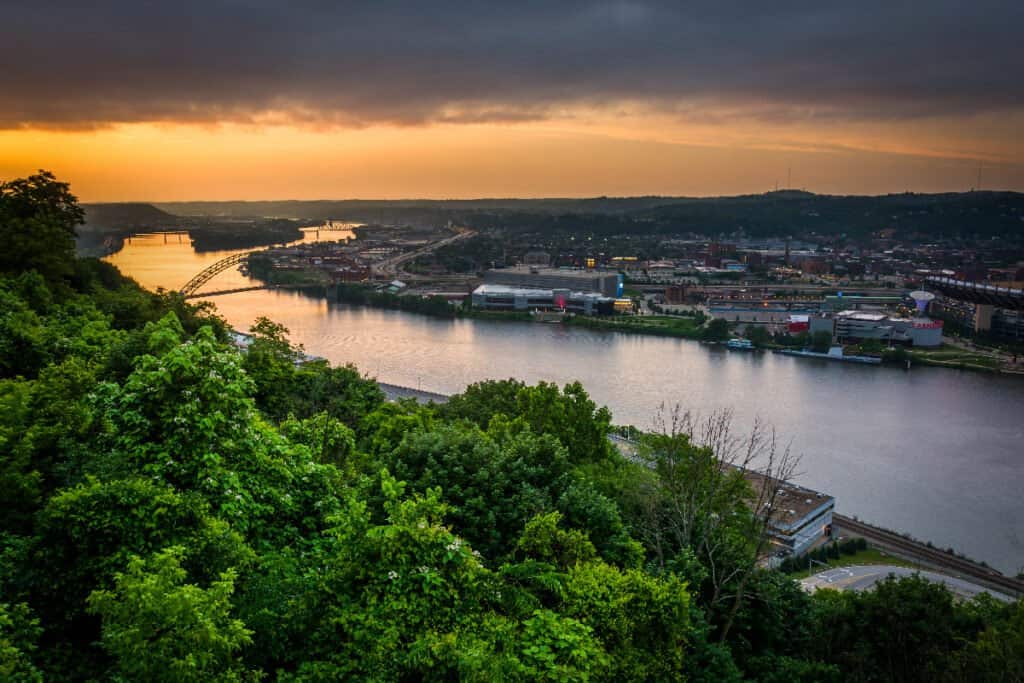
The Ohio River starts at the Midwestern and Southern United States boundary and ends where it joins the Mississippi River in Cairo, Illinois.
©ESB Professional/Shutterstock.com
The Ohio River is the lowest point in Indiana. Marking Indiana’s entire southern border, it plays a critical role in the area’s ecological and economic dynamism.
The River’s Origin and Route
The journey begins where the Allegheny and the Monongahela Rivers intersect in the lush, green mountains of Pennsylvania. This confluence gives birth to the Ohio River, a significant geographical feature that winds its way across approximately 981 miles. The river serves as an aquatic thread that weaves through six states, carrying with it a rich historical and ecological narrative.
Indiana’s Natural Border
As the Ohio River flows westward, it encounters the geographical boundary of Indiana. This rendezvous occurs at the tripoint where Indiana, Ohio, and Kentucky share borders. From this juncture, the river takes on the additional role of delineating Indiana’s southern frontier. For about 475 miles, nearly half of its total length, the Ohio River assumes the responsibility of acting as a natural border, shaping the state’s southern landscape in a significant way.

Ohio River banks along the border of Evansville, Indiana, and Kentucky.
©Conrad Crawford/Shutterstock.com
The River’s Depth and Elevation
At the southern edge of Indiana, the Ohio River’s water surface sits lower than any other geographical point in Indiana. The most precipitous drop in elevation occurs near the junction with the Mississippi River, where the water’s surface is a mere 320 feet above sea level. The state’s average elevation is approximately 700 feet.
To grasp this in contrast, Hoosier Hill, the highest point in Indiana, stands proudly at 1,257 feet, making the river’s low elevation all the more noteworthy.
River Morphology and Biodiversity
The Ohio River is not a static geographical entity. It’s a dynamic watercourse that constantly changes and adapts. It carves a sinuous, winding path, creating a complex network of oxbow lakes and river islands in its wake. These twists and turns give rise to diverse micro-habitats, making the Ohio River a vibrant hub for various species. The river and its surrounding environment support a wide range of flora and fauna, from aquatic lifeforms that inhabit its depths to land animals and bird species that thrive in the riparian zones along Indiana’s lowest point.
Cities and Towns Along the Ohio River
Several cities and towns in Indiana nestle against the Ohio River, each adding a unique flavor to the river’s extensive narrative. Key urban areas include Evansville, Indiana’s third-largest city, known for its vibrant riverfront, and Jeffersonville, which boasts a historic downtown area and a lively arts scene. Other important riverside towns include New Albany, with its rich architectural heritage, Madison, with its picturesque riverfront; and Tell City, known for its Swiss-German roots.
Environmental Features and Landmarks
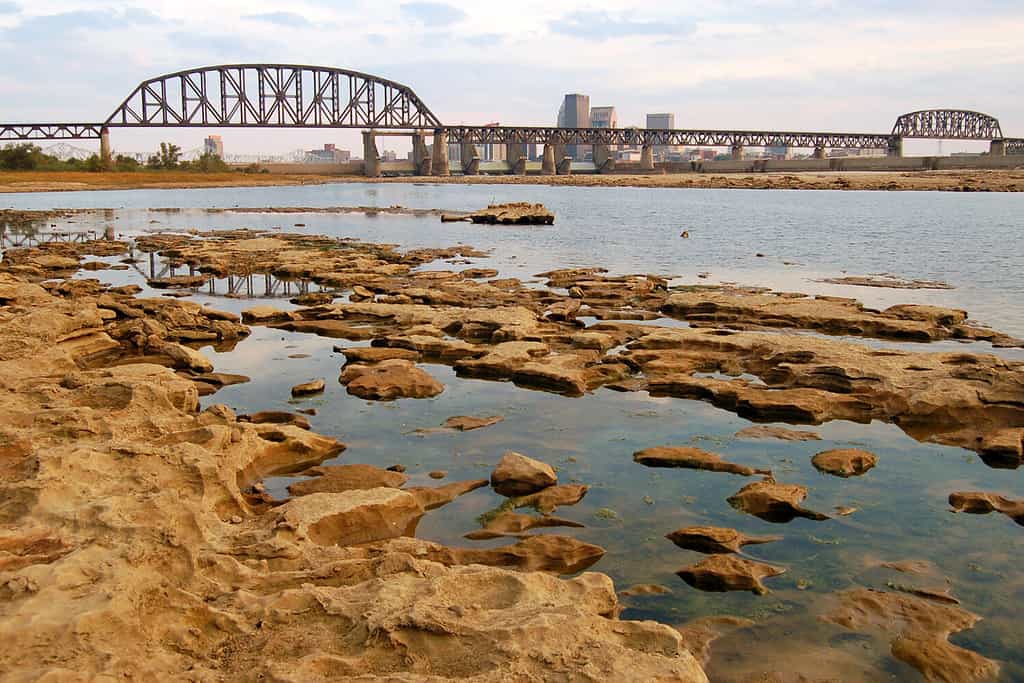
The river bed in the Falls of the Ohio State Park contains fossils from the Devonian period.
©James Kirkikis/Shutterstock.com
Beyond the urban areas, the Ohio River shapes a diverse and intriguing landscape within Indiana at its lowest point. The river helps create the unique geological formations found in the Ohio River Scenic Byway. It gives birth to the stunning Falls of the Ohio State Park, where fossil beds dating back millions of years invite exploration and awe. Along its route, the river also carves out numerous inlets and tributaries, creating habitats for diverse species and adding to the richness of Indiana’s environmental tapestry.
History of the Ohio River
The Ohio River, meandering along Indiana’s southern border, has carved not only the state’s landscape but also its history, playing a pivotal role in shaping the region’s past.
Early Exploration and Discovery
The Ohio River’s story intertwines with the early history of North America. Native American tribes such as the Shawnee, Miami, and Iroquois inhabited the river’s banks long before European explorers set foot on the continent. In the 17th century, French explorers charted the river’s course, and the area soon became a significant frontier in the struggle for control between the French and British empires.
Role in Indiana’s State Development
The river’s vast and navigable waters were instrumental in Indiana’s development. The river facilitated the transport of people and goods, contributing to the growth of cities like Evansville and Jeffersonville. The Ohio River was also crucial in the state’s industrial development, with industries such as shipbuilding, coal mining, and steel production flourishing along its banks.

Three bridges over the Ohio River between Jeffersonville, IN, and Louisville, KY.
©Thomas Kelley/Shutterstock.com
Major Historical Events
The Ohio River has been a silent witness to many pivotal events in American history. During the Civil War, the river marked a boundary between North and South, with Indiana remaining with the Union. The Underground Railroad, a clandestine system of covert paths and shelters utilized by enslaved African Americans in their quest for liberty, was also active along the Ohio River. For many, the river served as a powerful symbol, delineating the line between captivity and emancipation.
Fun Facts about the Ohio River
The Ohio River, a geographical and historical icon, also boasts a collection of intriguing facts that add layers of interest to its established narrative. It is so much more than just Indiana’s lowest point.
Geographical and Historical Trivia
In terms of length, the Ohio River isn’t a mere footnote. This impressive waterway holds the tenth position in the list of the longest rivers in the United States. Moreover, when it comes to the grand Mississippi River, the Ohio River takes the crown as the most voluminous tributary, contributing the most water. Interestingly, the Ohio River outdoes the Mississippi in terms of flow rate at the point of confluence.
Despite its name, the Ohio River doesn’t just belong to Ohio. It graces six states on its course: Pennsylvania, Ohio, West Virginia, Kentucky, Indiana, and Illinois. Each of these states bestows a unique persona onto the river, enriching its journey with distinct flavors.
Unique Species and Ecosystems
The river is home to over 160 species of fish, far outnumbering the variety in many other U.S. water bodies. Additionally, it supports numerous mussel species, many of which are nowhere else to be found.

The zebra mussel was brought to the United States on ships and continues to colonize new areas, including the Ohio River.
©iStock.com/VitalisG
Record-Setting Events and Achievements
The Ohio River has also set the stage for some incredible human achievements. One notable example is the Great Ohio River Swim. This annual event challenges participants to swim across the river and back, a unique feat that turns the river from a geographical feature into a test of human endurance.
What Makes the Ohio River a Special Place to Visit?
The Ohio River, with its rich history, vibrant ecosystems, and scenic beauty, offers an unmatched experience to visitors, making it a unique destination in the heart of America.
Key Attractions Along the Ohio River
The river is a hub of numerous attractions that captivate a wide range of interests. The Falls of the Ohio State Park offers an open-air museum of sorts with its ancient fossil beds. The riverfront cities of Evansville and Jeffersonville charm visitors with their lively arts scenes, historical landmarks, and bustling downtown areas.
Cultural Significance
The Ohio River holds significant cultural value. The river’s history has deeply influenced local traditions, art, and folklore, which visitors can experience through various community events, museums, and cultural festivals held along its banks. The river is not just a place to visit but also a place to immerse oneself in the rich tapestry of local cultures.
Unique Experiences Only Available at the Ohio River
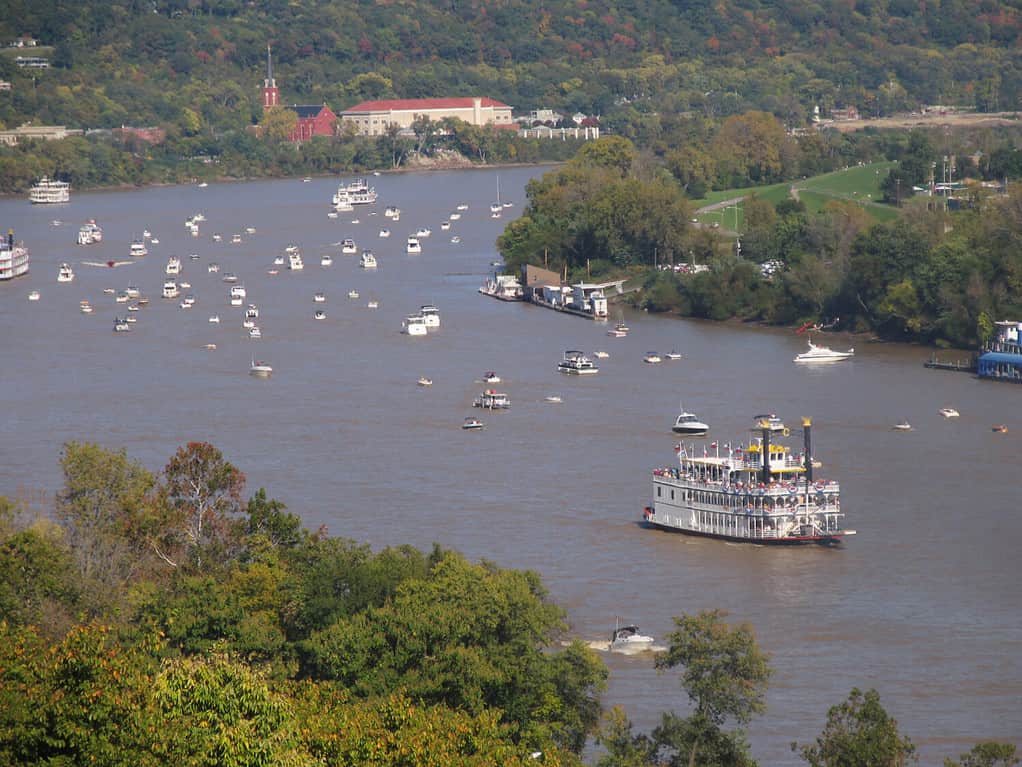
Riverboat cruises along the Ohio River are a favorite pastime of locals and visitors alike.
©vadim kozlovsky/Shutterstock.com
The Ohio River offers unique experiences that visitors cannot find elsewhere. From thrilling riverboat cruises that offer breathtaking views of the river’s landscape to fishing excursions that provide encounters with the river’s diverse fish species, the Ohio River ensures a memorable visit. Moreover, bird watching along the river, particularly during migratory seasons, presents an unforgettable spectacle of nature.
Animals of the Ohio River
The Ohio River is an ecological treasure trove, a life-giving artery that nurtures a remarkable assortment of fauna. This vibrant array of wildlife, thriving within the river’s waters, along its banks, and in the surrounding landscapes, enriches the river’s dynamic character.
Aquatic Life

Smallmouth Bass are common in the Ohio River.
©K Steve Cope/Shutterstock.com
Under the river’s surface, a world teeming with life flourishes. The Ohio River is home to more than 160 species of fish, including Smallmouth Bass, Walleye, and the endangered Spotted Darter and Ohio Lamprey. In addition, the river is a sanctuary for around 50 species of Freshwater Mussels, some of which, like the Fanshell and the Pink Mucket, face the risk of extinction.
Birdlife
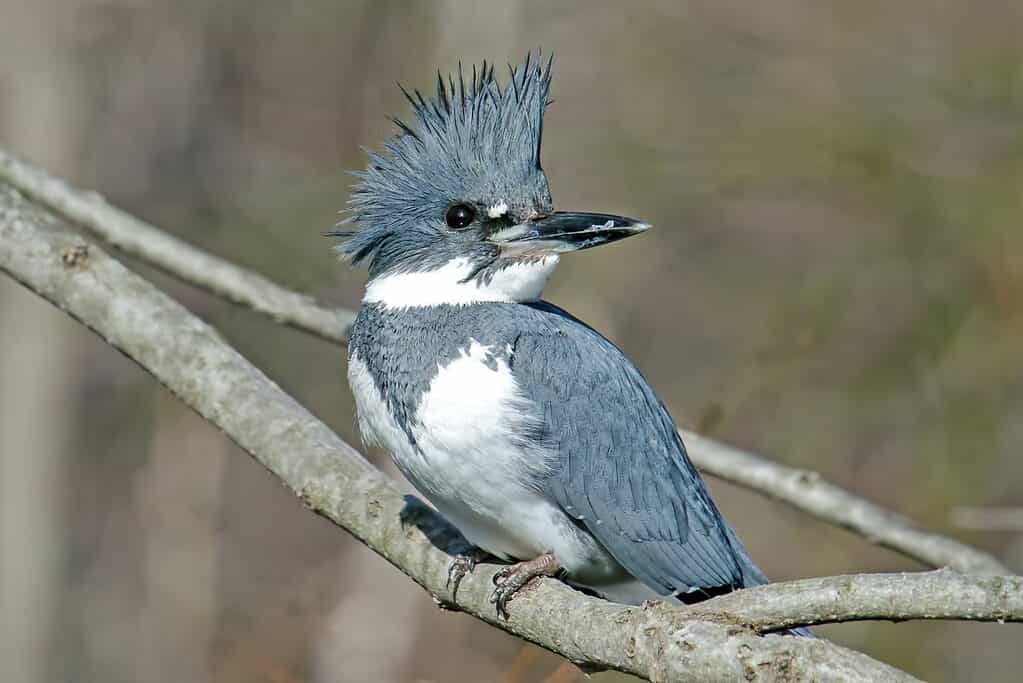
Belted Kingfishers are stocky, large-headed birds with a shaggy crest on the top and back of the head and a straight, thick, pointed bill.
©iStock.com/BrianEKushner
The Ohio River’s surrounding landscapes provide ideal habitats for a variety of bird species. Renowned species such as the Bald Eagle, Great Blue Heron, and Belted Kingfisher adorn the banks of the river. Moreover, during migration seasons, the river transforms into a bustling corridor for migratory birds, hosting everything from Warblers to Waterfowl and offering bird enthusiasts a rich spectacle.
Mammals

An adorable river otter sticking its tongue out.
©iStock.com/Heather Burditt
An array of mammals also frequents the Ohio River’s riparian zones and nearby woods. Semi-aquatic species such as Beavers, Muskrats, and River Otters thrive around the water. Further into the forested regions, you can find White-tailed Deer, Red Foxes, and Coyotes marking their territories.
Reptiles

Unlike many other species in the turtle family, eastern box turtles are terrestrial.
©outdoorsports44/Shutterstock.com
Reptiles, too, are part of the Ohio River’s rich biodiversity. The river and its surrounding environments provide habitats for various species, including the Eastern Box Turtle and Northern Water Snake, adding another level of ecological interest to this waterway.
Insect Life

Damselflies hold their wings closed when at rest.
©iStock.com/dmf87
The river’s edges come alive with a wide variety of insects. From butterflies to dragonflies and damselflies, these often overlooked creatures play vital roles in the ecosystem, pollinating plants and serving as food for other wildlife.
Visitor Statistics to the Ohio River
Year after year, the Ohio River attracts an impressive number of visitors. The river, flowing gracefully along Indiana’s southern edge, magnetizes adventurers, history buffs, nature lovers, and casual tourists alike.
How Many People Visit the Ohio River Each Year?
Each year, approximately 3 million people come to the Ohio River. They’re drawn by its natural beauty, historical significance, and recreational opportunities. This statistic speaks volumes about the river’s appeal, making it one of the most visited natural attractions in the region.
What Are the Most Popular Tourist Activities at the Ohio River?
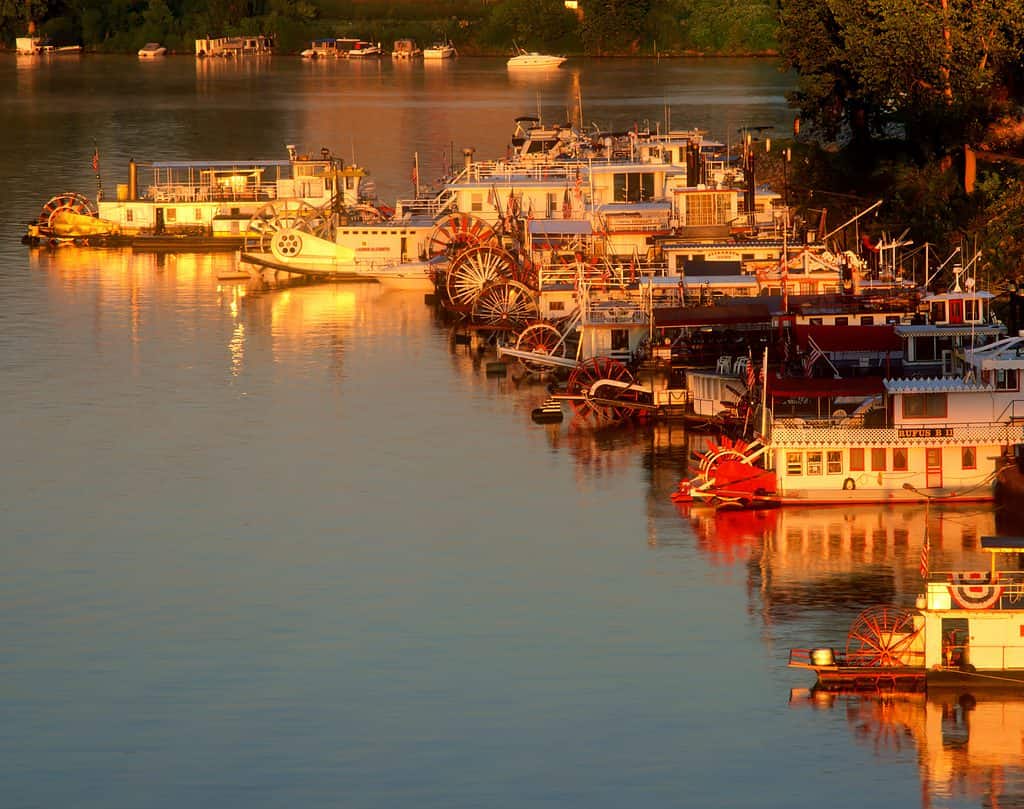
Marietta, OH, came to be known as “Riverboat Town,” nestled along the Ohio River.
©iStock.com/LarryKnupp
Visitors to the Ohio River engage in a myriad of activities. Water sports enthusiasts find their adrenaline rush in boating, kayaking, and fishing. While others take it easy on riverboat tours. Wildlife observers, armed with binoculars and field guides, cherish the river’s rich biodiversity. History seekers embark on a journey through time, visiting sites of historical importance along the river’s path. Picnickers and campers appreciate the river’s scenic beauty. Hikers and bikers enjoy the miles of trails that follow the river’s edge.
Peak Seasons
The Ohio River sees a surge in visitors during the warmer months, particularly between May and September. During this time, the river’s landscapes are at their most vibrant, and outdoor activities are in full swing. However, each season offers its unique charm and a different perspective on the river’s beauty.
Tourism Impact
The tourism industry around the Ohio River contributes significantly to local economies. Restaurants, hotels, tour operators, and local businesses thrive on the influx of visitors. Moreover, events like river festivals, fishing tournaments, and boat races attract large crowds, further boosting local commerce.
Key Takeaways
The Ohio River, as we have seen, is more than just a geographical feature. This vibrant waterway breathes life into the heart of America. It shapes landscapes, fosters diverse ecosystems, and carries with it the rich tapestry of human history.
From the heights of the Allegheny Mountains, where it begins its journey, to its sojourn at Indiana’s southern border, to its confluence with the Mississippi, the Ohio River wears many hats. It’s a stage for human achievement, a hub for wildlife, a source of economic prosperity, and a witness to historical events.
The river’s path, where it sinks to become Indiana’s lowest point, invites us to reconsider our understanding of low points. Here, the “lowest” is not a deficit but a strength. It’s not a place to avoid but a place to seek out—a place of rich biodiversity, thrilling human endeavor, and of scenic beauty.
The photo featured at the top of this post is © Corey B Stevens/Shutterstock.com
Thank you for reading! Have some feedback for us? Contact the AZ Animals editorial team.







